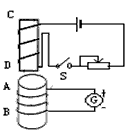问题
不定项选择
如图,用线圈CD放入线圈AB内(线圈绕法如图),演示电磁感应现象,当电流计中的电流从上面的正接线柱流入时,电流计的指针右偏,当电流从下面的负接线柱流入时,电流计的指针左偏,下列看到的哪些现象是正确的[ ]

A.电键S闭合的瞬间,看到电流计的指针左偏
B.电键S由闭合再打开的瞬间,看到电流计的指针左偏
C.只要电路中的电流足够大,滑动变阻器无须移动,指针就会发生偏转
D.当滑动变阻器向左移动的过程中,电流计的指针左偏
答案
答案:A
